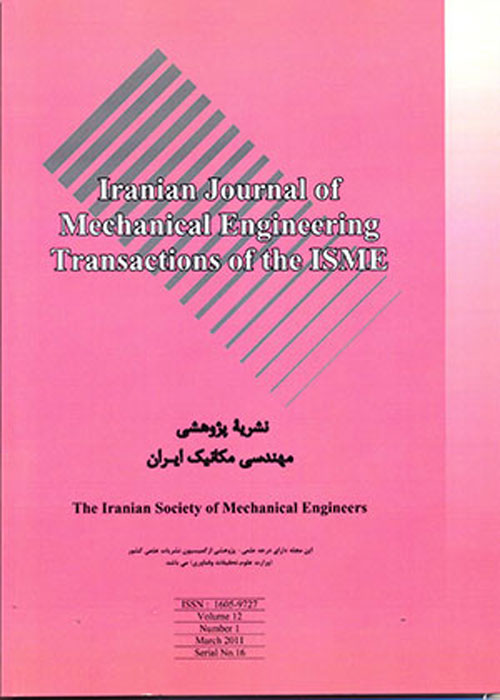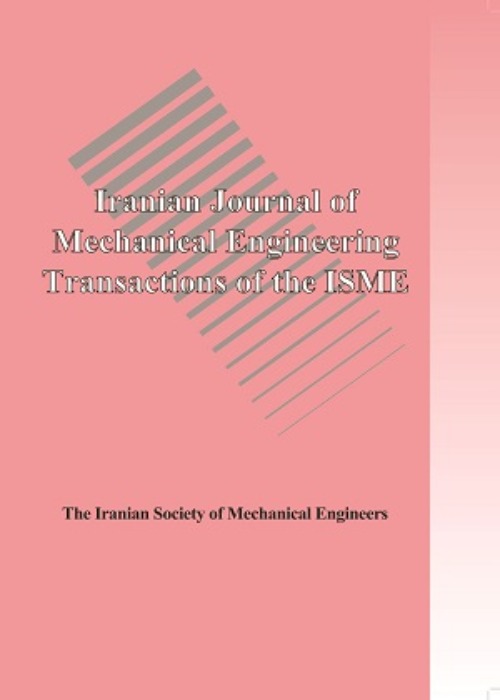فهرست مطالب

Iranian Journal of Mechanical Engineering Transactions of ISME
Volume:17 Issue: 2, Sep 2016
- تاریخ انتشار: 1396/09/07
- تعداد عناوین: 6
-
-
Pages 5-18In this study, the exergy efficiency of a flat plate solar collector using Al2O3, TiO2, CuO nanoparticles and pure water as base fluid is studied. Solar radiation is selected between 200 to 600 W/m2. The method to determine optimum values of optimization variables has been developed by Genetic Algorithm Toolbox in MATLAB software. Results show by increasing solar radiation the optimized exergy efficiency is increased 3.72% for Al2O3 and TiO2nanofluids and 3.6% for CuO nanofluid. According to optimum values of mass flow rate of fluid, 15.22% for Al2O3 and TiO2 nanofluids and 4.35% for CuO nanofluid is decreased, also collector inlet temperature is decreased about 0.8% for all nanofluids. By increasing wind speed and ambient temperature for both cases, the exergy efficiency increased and decreased respectively. Using nanofluids decreased 0.4% overall loss coefficient of collector.Keywords: Exergy, Nanofluid, Flat plate, Solar Collector, Genetic Algorithm
-
Multiple cracks in an elastic half-plane subjected to thermo-mechanical loadingPages 19-45An analytical solution is presented for the thermoelastic problem of a half-plane with several cracks under thermo mechanical loading using distributed dislocation technique. The uncoupled quasi-static linear thermoelasticity theory is adopted in which the change in temperature, if any, due to deformations is neglected. The stress field in a half-plane containing thermoelastic dislocation is obtained by means of the complex Fourier transform. Then, the problem is reduced to the solution of a set of simultaneous integral equations with Cauchy type singularities for dislocation density functions. Numerical results for the modes I and II stress intensity are presented to illustrate the effects of crack geometry and loading conditions on the stress intensity factors.Finally, the different cases of crack configurations and arrangements are examined.Keywords: Thermal stress, Elastic half-plane, Thermoelastic dislocation, Multiple cracks, Stress intensity factors
-
Pages 46-66In this study buckling analysis of solid rectangular plate made of porous material bounded with the layers of piezoelectric actuators in undrained condition is investigated. Porous material properties vary through the thickness of plate with a specific function. Distributing of the pores through the plate thickness is assumed to be the nonlinear nonsymmetric distribution. The general mechanical non linear equilibrium and linear stability equations are derived using the variational formulations to obtain the governing equations of piezoelectric porous plate. The effects of piezoelectric layers on critical buckling load of plate, piezoelectric layer-to-porous plate thickness ratio and actuator voltage are studied. Also, effect of fluid compressibility and variation of porosity on critical buckling load are investigated in the undrained condition.Closed-form solutions is used to derive the critical buckling loads of the plate subjected to mechanical loading.The results obtained for porous plates with the layers of piezoelectric actuators are verified with the known data in literature.Keywords: Buckling analysis, Rectangular plate, Functionally graded plate, Porous material
-
Pages 67-83In this paper, modal analysis of the fluid-structure interaction has been investigated. Using classical laminated plate theory, a closed form solution for natural frequencies of FSI is extracted. For fluid, homogenous, inviscid and irrotational fluid flow is assumed. Then, a combined governing equation for the plate-fluid system is derived. In order to validate the equations and results, they are compared with results reported in other literatures. The vibration behavior for different plate length to width ratios are also studied. For the forced vibration, three cases; harmonic point load, distributed loading and step pressure loading; are performed and for each case, the time response of plate-fluid system is obtained. Also, frequency response of plate-fluid system has been achieved for harmonic load.Keywords: modal analysis, natural frequency, mode shape, fluid-structure interaction, composite plate
-
Pages 84-100A spatial parallel mechanism namely 3-RRS mechanism has been assigned to be attached to the seat of a standard electric wheelchair to prevent the turning over of the handicapped sitting on the wheelchair. The system of the wheelchair and the mechanism is a self-balancing robotic wheelchair and has coped with several road conditions. A stability control system calculates the proper moments on the basis of the height of the mass centre and the angle of the wheelchair. The control parameters have obtained and the revolute motors have been actuated by the control torques. Based on the simulation results of the system in MatLab, two types of stabilized wheelchairs, one of which has shown good results on several road conditions, have been built and tested.Keywords: Parallel robot, Spatial 3-RRS robot, Wheelchair stability control, Turn-over prevention
-
Pages 101-110noses by using the equivalent axisymmetric body (EAB) theory. This Code has been developed by researchers and the results of it have been validated by the various flight tests results. In the case of non-zero angle of attack or asymmetric surface ablation for each meriodinal plane, the equivalent meriodinal plane (EMP) is created for any meriodinal plane. The combinations of these planes constitute the EAB. The governing equations are solved for this body by using the non-equilibrium chemical reactions and the results of it are mapped to the main body. The solving of a typical nose during flight trajectory show that the convergence of this technique is very fast as compare to the user defined function (UDF) based on the fluent solvers. The results of this research are validated by the UDF and the relative error of it is less than 10 percent.Keywords: CTCA (Calculating of Temperature Contour, Aero, heating) Code, EAB (Equivalent Axisymmetric Body) Theory, EMP (Equivalent Meriodinal Plane), UDF (User Defined Function)


